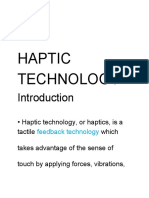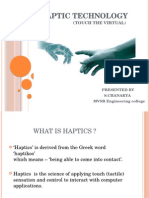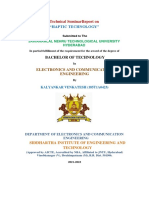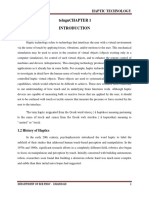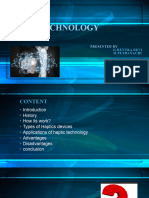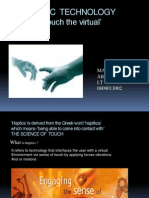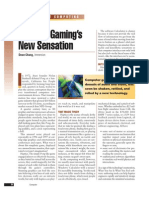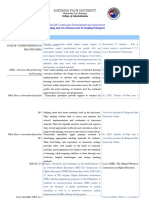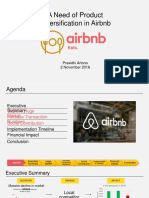0% found this document useful (0 votes)
200 views6 pagesForces Vibrations Computer Simulation Teleoperators Tactile
Haptic technology uses tactile feedback via forces, vibrations, and motions to enhance the sense of touch. This allows for more realistic control of virtual objects and remote machines. Haptics can also be used to study how human touch works by creating controlled virtual objects. Current applications include teleoperation devices, simulators, video games, mobile technologies, virtual reality, research, medicine, robotics, and arts/design. Future areas may involve holographic interaction and advanced medical applications.
Uploaded by
Nanditha AithaCopyright
© Attribution Non-Commercial (BY-NC)
We take content rights seriously. If you suspect this is your content, claim it here.
Available Formats
Download as DOCX, PDF, TXT or read online on Scribd
0% found this document useful (0 votes)
200 views6 pagesForces Vibrations Computer Simulation Teleoperators Tactile
Haptic technology uses tactile feedback via forces, vibrations, and motions to enhance the sense of touch. This allows for more realistic control of virtual objects and remote machines. Haptics can also be used to study how human touch works by creating controlled virtual objects. Current applications include teleoperation devices, simulators, video games, mobile technologies, virtual reality, research, medicine, robotics, and arts/design. Future areas may involve holographic interaction and advanced medical applications.
Uploaded by
Nanditha AithaCopyright
© Attribution Non-Commercial (BY-NC)
We take content rights seriously. If you suspect this is your content, claim it here.
Available Formats
Download as DOCX, PDF, TXT or read online on Scribd
/ 6










